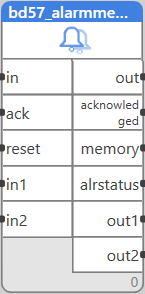Extended alarm memory
Block name
BD57_ALARMMEMORYEXT
ST call
PROGRAM TEST BD57 VAR BOOL1, BOOL2, BOOL3, BOOL4, BOOL5, BOOL6:BOOL; FB : LIB.CORE.V1_1.BD57_ALARMMEMORYEXT; END_VAR FB.IN[1] := BOOL3; FB.IN[2] := BOOL4; FB(ACK1:=BOOL1,RESET1:=BOOL2); BOOL5 := FB.OUT[1]; BOOL6 := FB.OUT[2]; END_PROGRAM
Library
LIB\CORE
Version
V1.1
Description
The block is an alarm memory with up to 16 alarm inputs.
Inputs
| Input | Type | Description | Default value |
| IN | MULTIIOBOOL | Alarm inputs as array | [False,…,False] |
| ACK1 or ACK2 | BOOL | Alarm acknowledge | False |
| RESET1 or RESET2 | BOOL | Alarm memory reset | False |
| IN0,IN1,..,IN15 | BOOL | Alarm inputs, individually |
Outputs
| Output | Type | Description |
| OUT | MULTIIOBOOL | Alarm outputs as an array |
| ACKNOWLEDGED | MULTIIOBOOL | Indication that the alarm has been acknowledged |
| MEMORY | BOOL | Alarm memory |
| ALRSTATUS | INT | Alarm status |
| OUT0,OUT1,..,OUT15 | BOOL | Alarm outputs, individually |
Function
The block is a memory block which keeps alarm status for display in SCADA or for interlocking of the controlled aggregates. After a rising edge on any of the in… inputs the block goes into alarm, indicating alarm memory at the memory output. The alarm can be acknowledged either via SCADA or other client, or by bringing a rising edge to the ack input. Then, the acknowledged output goes to TRUE. After the alarm signal disappears (in goes to FALSE), the alarm can be reset by bringing a rising edge to the reset1 or reset2 inputs. Note that the ST indeces of the IN array are 1 to 16 rather than 0 to 15.
Values of alrstatus:
- alrstatus=256 - at least one alarm is active
- alrstatus=512 - at least one alarm has been acknowledged
- alrstatus=1024 - memory = true, alarm is unacknowledged and unreset.
The alrstatus value may be a composition of more above mentioned indicators.
Application example

The alarm block is one of the most frequently used blocks in the HVAC control programs. It is used for safety interlock of pumps and fans, which are prevented from operation until their alarm blocks are reset manually over a HMI or SCADA (or by a general alarm reset button at the panel door). The extended version of the classical Alarm block can be used where it is required to have a common memory for more alarms of similar type, such as exceeding of room humidity in a group of rooms.
